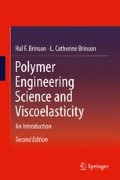Abstract
The various approaches to the solution of viscoelastic boundary value problems discussed in the last chapter for bars and beams carry over to the solution of problems in two and three dimensions. In particular, if the solution to a similar problem for an elastic material already exists, the correspondence principle may be invoked and with the use of Laplace or Fourier transforms a solution can be found. Such solutions can be used with confidence but one must be cognizant of the general equations of elasticity and the methods of solutions for elasticity problems in two and three dimensions as well as any assumptions that might often be applied. To provide all of the necessary information and background for multidimensional elasticity theory is beyond the scope of this text but the procedures needed will be outlined in the following sections.
Access this chapter
Tax calculation will be finalised at checkout
Purchases are for personal use only
Notes
- 1.
† Note that in this and the following equations the comma is used in the subscripts on stress to be able to write both the radial and hoop stresses in one equation. Since the form of these stresses differs only by a minus sign, it is preferred to emphasize their similarity by this nonstandard notation rather than write the two equations separately.
References
Arridge, R.G.C., J. of Physics E: Scientific Instruments, 1974 Volume 7, 1974, p.399-401.
Christensen, R.M., Theory of viscoelasticity, 2nd ed., Academic Press, 1982. (Also see Dover Edition, 2003)
Duran, R.S. and McKenna, G.B.: A torsional dilatometer for volume change measurements on deformed glasses: Instrument description and measurements on equilibrated glasses, J. Rheol. 34, 1990, p. 813–839.
Durelli, A.J., Phillips, E.A. and Tsao, C.H., Introduction to the Theoretical and Experimental Analysis of Stress and Strain, McGraw-Hill, NY, 1958.
Emri, I and T. Prodan: A Measuring System for Bulk and Shear Characterization of Polymers, Experimental Mechanics, V., 46, No. 4, August 2006, p. 429–439.
Ferry, J.D., Viscoelastic Properties of Polymers, 3rd ed., JW, NY, 1980.
Flügge, W., Viscoelasticity, Springer-Verlag, NY, 1974.
Graham, G.A.C., “The Correspondence Principle of Linear Viscoelasticity Theory for Mixed Boundary Value Problems Involving Time-Dependent Boundary Regions”, Quart. Appl. Math. 26, 1968, p. 167–174.
Kenner, V. H., Knauss, W. G., Chai, H., “A Simple Creep Torsiometer and its Use in the Thermorheological Characterization of a Structural Adhesive”, Experimental Mechanics, Feb., 1982, p. 75–80.
Lakes, R. S., Viscoelastic solids, CRC Press, Boca Raton, FL, (1998).
Lee, E. H., “Stress Analysis of Viscoelastic Bodies”, in Viscoelasticity: Phenomenological Aspects (J.T. Bergen, Ed.), Wiley, 1960.
Park, S.J., Liechti, K.M. and Roy, S.: Simplified bulk experiments and hygrothermal nonlinear viscoelasticity, Mech. Time-Depend Mat. 8, 303–344 (2004).
Sakai, M., Philosophical Magazine, Vol. 86, 5607–5624, “Elastic and viscoelastic contact mechanics of coating/substrate composites in axisymmetric indentation”, (2006).
Sane, S. and Knauss, W.G.: The time-dependent bulk response of poly (methyl methacrylate), Mech. Time Depend. Mat. 5, 293–324, 2001.
Shames, I.H. and Cozzarelli, F.A., Elastic and Inelastic Stress Analysis, Prentice Hall, 1992.
Timoshenko, S.P. and Goodier, J.N., Theory of Elasticity, McGraw Hill, NY, 1970.
Tschoegl, N.W., Knauss, W. G., and Emri, I., “Poisson’s Ratio in Linear Viscoelasticity – A Critical Review”, Mech. of Time-Dependent Materials 6: 3–51, 2002.
Author information
Authors and Affiliations
Rights and permissions
Copyright information
© 2015 Springer Science+Business Media New York
About this chapter
Cite this chapter
Brinson, H.F., Brinson, L.C. (2015). Viscoelastic Stress Analysis in Two and Three Dimensions. In: Polymer Engineering Science and Viscoelasticity. Springer, Boston, MA. https://doi.org/10.1007/978-1-4899-7485-3_9
Download citation
DOI: https://doi.org/10.1007/978-1-4899-7485-3_9
Published:
Publisher Name: Springer, Boston, MA
Print ISBN: 978-1-4899-7484-6
Online ISBN: 978-1-4899-7485-3
eBook Packages: EngineeringEngineering (R0)

